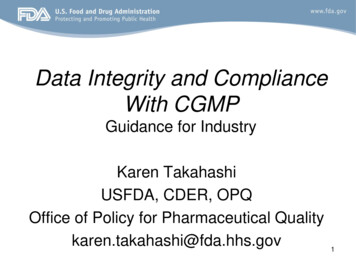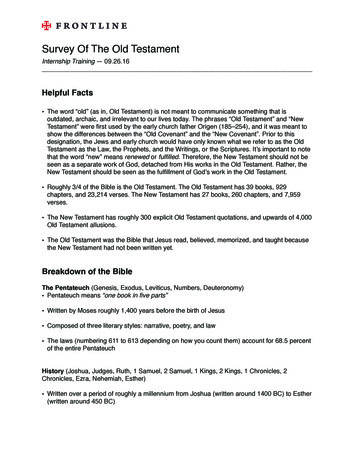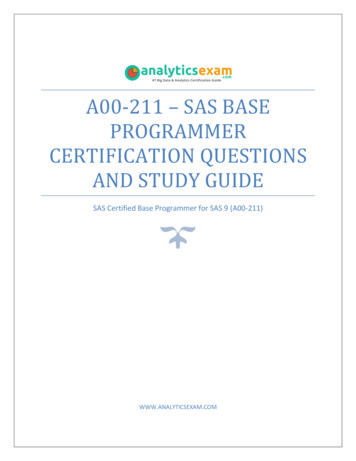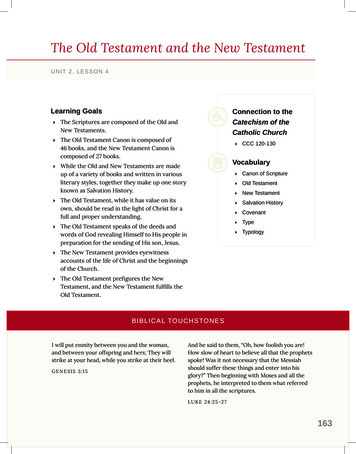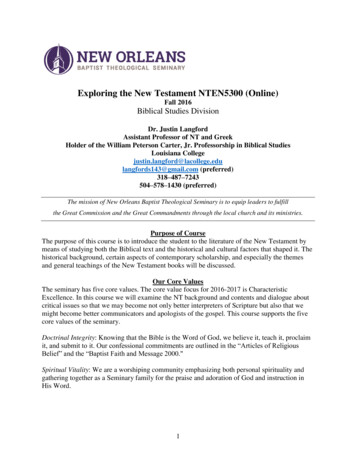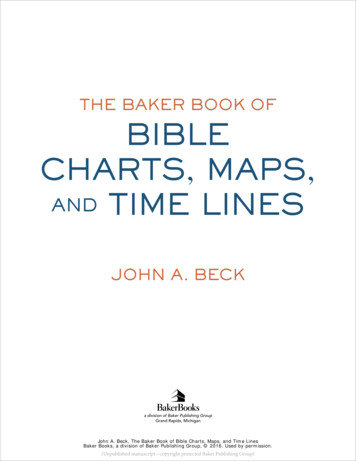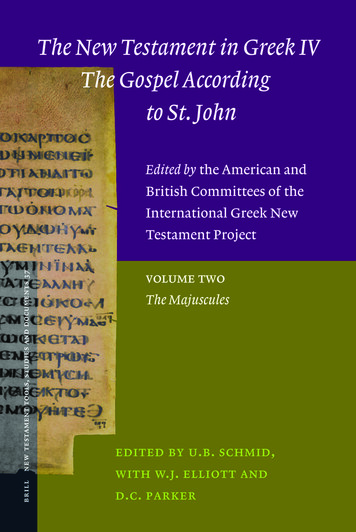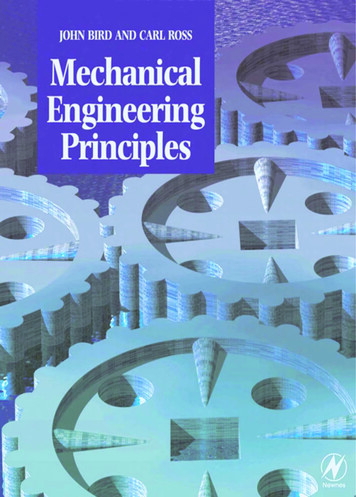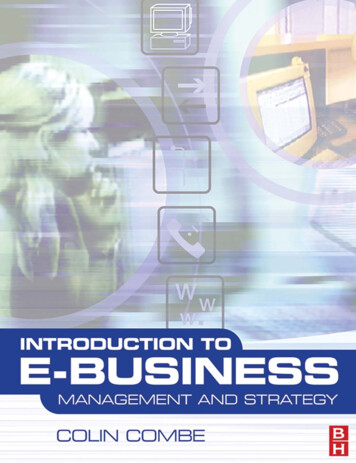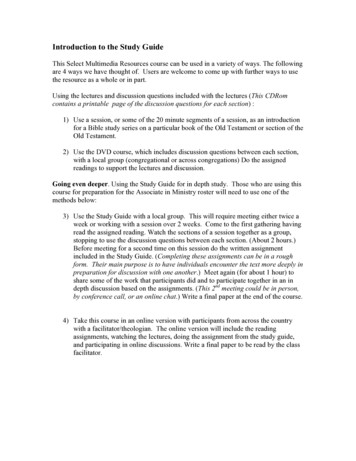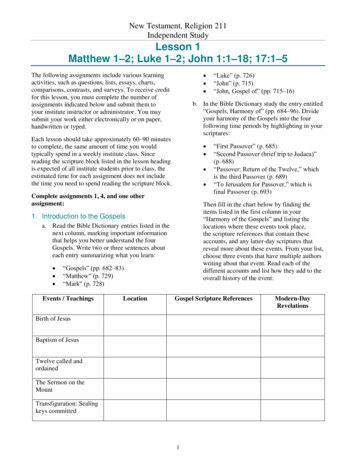
Transcription
New Testament, Religion 211Independent StudyLesson 1Matthew 1–2; Luke 1–2; John 1:1–18; 17:1–5 The following assignments include various learningactivities, such as questions, lists, essays, charts,comparisons, contrasts, and surveys. To receive creditfor this lesson, you must complete the number ofassignments indicated below and submit them toyour institute instructor or administrator. You maysubmit your work either electronically or on paper,handwritten or typed.b. In the Bible Dictionary study the entry entitled“Gospels, Harmony of” (pp. 684–96). Divideyour harmony of the Gospels into the fourfollowing time periods by highlighting in yourscriptures:Each lesson should take approximately 60–90 minutesto complete, the same amount of time you wouldtypically spend in a weekly institute class. Sincereading the scripture block listed in the lesson headingis expected of all institute students prior to class, theestimated time for each assignment does not includethe time you need to spend reading the scripture block. Complete assignments 1, 4, and one otherassignment:a. Read the Bible Dictionary entries listed in thenext column, marking important informationthat helps you better understand the fourGospels. Write two or three sentences abouteach entry summarizing what you learn:“Gospels” (pp. 682–83)“Matthew” (p. 729)“Mark” (p. 728)Events / TeachingsLocation“First Passover” (p. 685)“Second Passover (brief trip to Judaea)”(p. 688)“Passover: Return of the Twelve,” whichis the third Passover (p. 689)“To Jerusalem for Passover,” which isfinal Passover (p. 693)Then fill in the chart below by finding theitems listed in the first column in your“Harmony of the Gospels” and listing thelocations where these events took place,the scripture references that contain theseaccounts, and any latter-day scriptures thatreveal more about these events. From your list,choose three events that have multiple authorswriting about that event. Read each of thedifferent accounts and list how they add to theoverall history of the event:1. Introduction to the Gospels “Luke” (p. 726)“John” (p. 715)“John, Gospel of” (pp. 715–16)Gospel Scripture ReferencesBirth of JesusBaptism of JesusTwelve called andordainedThe Sermon on theMountTransfiguration: Sealingkeys committed1Modern-DayRevelations
Lesson 1Matthew 1–2; Luke 1–2; John 1:1–18; 17:1–5Events / TeachingsLocationGospel Scripture ReferencesModern-DayRevelationsParable: The goodSamaritanThe Last Week:Atonement andResurrectionJesus’s suffering andprayersThe crucifixionFirst day: Earthquake,angels open tombc. Explain in writing how this section about theharmony of the Gospels could be helpful inyour study of the life and ministry of theSavior.4. Matthew 1–2; Luke 1–2. The Birth ofJesus Christa. Study Matthew 1–2 and the student manualcommentary for Matthew 1:18–25, “Mary WasEspoused to Joseph” (pp. 22–23). Respond inwriting to the following questions:2. John 1:1–14; 17:1–5. The Premortal andMortal Savior a. Search John 1:1–14; 17:1–5 and ponder thedoctrinal connect between the two references.List at least five truths you learn about thepremortal Jesus Christ and five truths you learnabout His mortal life.b. Learn more about the following names or titlesof the Savior. Use the Bible Dictionary and theinstitute student manual commentary for John1:1, “How Is Jesus the Word of God?” (p. 15)and the commentary for “What Is the Meaningof the Titles ‘Christ,’ ‘Messiah,’ and‘Jehovah’?” (p. 18). Write one or twosentences about the meaning of each title: ChristMessiahJehovahImmanuelThe WordWhat did Joseph initially want to do whenhe found out Mary was with child?What did Joseph decide to do after the visitof the angel in his dream? What does thissuggest about Joseph’s character?How many times in these chapters wasJoseph guided by the Lord in a dream?What does this suggest about Joseph’sspiritual sensitivity?Although Joseph was not the literal fatherof Jesus, he was a righteous man entrustedby Heavenly Father to be a guardian to HisSon in mortality. Write about at least twoqualities Joseph demonstrated that youthink you could develop to help youprepare to be a good parent.b. How is Mary referred to in Luke 1:28? Fromthe account in Luke 1:26–56 make a list ofMary’s qualities that you think distinguish heras one who would be “favoured” by God withthe special mission of being the mother of themortal Messiah. Write a paragraph about oneof Mary’s qualities you want to develop morefully and what difference it would make inyour life.c. Matthew 1:1–17; Luke 3:23–38 containgenealogies of Jesus Christ. In the student3. Luke 1:5–80. The Birth of John the BaptistRead Luke 1:14 and write what Zacharias wastold about the birth of his son, John the Baptist.Study Luke 1:5–25, 39–45, 56–80 and the BibleDictionary entry, “John the Baptist” (pp. 714–15).Write a paragraph summarizing the reasons manypeople would rejoice over John the Baptist’s birthand mission.2 2009 by Intellectual Reserve, Inc. All rights reserved. English approval: 10/09. PD10019220
Lesson 1Matthew 1–2; Luke 1–2; John 1:1–18; 17:1–5manual, read the commentary for Matthew1:17; Luke 3:23–28, “Jesus Descended fromKings” (p. 22). Write a statement about thepossible significance of the genealogy of JesusChrist and why the two accounts are slightlydifferent.d. Read the student manual Points to Ponder,“Jesus Was the First Begotten in the Spirit andthe Only Begotten in the Flesh” (p. 16) and“Because God Was His Father, Jesus HadPower Over Life and Death” (p. 24). ReadJohn 10:17–18; Mosiah 3:7. Then write aparagraph explaining why it was necessary forJesus Christ to have an immortal Father and amortal mother.e. Study Luke 2:1–16 and complete the followingassignments: hew2:1–6)Nephites(3 Nephi1:12–22)b. Write a response to the question: What do Iknow about the Savior, how have I learned it,and what am I doing with what I know?a. Fill in the chart below as you study thescriptures indicated:WhoWhat theydid withtheirknowledgeWise Men(Matthew2:1–12)5. Luke 1:39–45; 2:8–38; Matthew 2:1–18.Others Who Learned of the Birth of JesusChristWhat theyknewabout theSaviorWhat theyknewabout theSaviorAnna(Luke2:36–38)Write six questions that cover what youthink are the most important details of theSavior’s birth. In parentheses after eachquestion, write the correct answer and theverse where the answer can be found.List five phrases from Luke 2:1–16 thatyou think would be good titles for a talkabout Jesus Christ at Christmastime.How theylearnedabout theSaviorHow theylearnedabout theSavior6. Luke 2:40–52; JST, Matthew 3:24–26.The Childhood of Jesus ChristWhat theydid withtheirknowledgeStudy Luke 2:40–52; Joseph Smith Translation,Matthew 3:24–26; Doctrine and Covenants93:12–14; student manual Points to Ponder, “JesusHad to Overcome the Veil” (pp. 24–25) and “As aChild, Jesus Sought to Learn from His Father” (pp.25–26). Then write an essay about what youlearned from the childhood of Jesus Christ thatcan help you in your personal growth uke2:8–18)Simeon(Luke2:25–35)3 2009 by Intellectual Reserve, Inc. All rights reserved. English approval: 10/09. PD10019220
New Testament, Religion 211Independent StudyLesson 2Matthew 3–4; Mark 1; Luke 3–4; John 1:19–4:54‘like a Dove’?” (pp. 28–29). Then write answers tothe following questions:The following assignments include various learningactivities, such as questions, lists, essays, charts,comparisons, contrasts, and surveys. To receive creditfor this lesson, you must complete the number ofassignments indicated below and submit them toyour institute instructor or administrator. You maysubmit your work either electronically or on paper,handwritten or typed. Each lesson should take approximately 60–90 minutesto complete, the same amount of time you wouldtypically spend in a weekly institute class. Sincereading the scripture block listed in the lesson headingis expected of all institute students prior to class, theestimated time for each assignment does not includethe time you need to spend reading the scripture block.3. Matthew 4:1–11; Luke 4:1–11.Temptations in the Wildernessa. Read Matthew 4:1–11. Then write answers tothe following questions:Complete assignment 7 and any three of the otherassignments: 1. Matthew 3:1–11; Mark 1:4–8; Luke3:1–14; John 1:7–9, 19–28. The Missionof John the Baptista. Describe in writing what was taught aboutJohn the Baptist and his mission in 1 Nephi10:7–10; 2 Nephi 31:4; Isaiah 40:3–4; Malachi3:1; Doctrine and Covenants 87:27–28. b. Read the following references and list waysJohn the Baptist fulfilled his mission asforetold: Why was John hesitant to baptize Jesus?What is taught here about the Holy Ghost?Jesus Christ said He must be baptized to“fulfill all righteousness.” List threereasons why Jesus Christ was baptized (see2 Nephi 31:6–11).What evidence is found in Matthew3:16–17 that the Father, Son, and HolyGhost are three separate personages in theGodhead? Matthew 3:1–4; Luke 3:4–6John 1:7–9, 19–28Matthew 3:7–11; Luke 3:7–14Matthew 3:6; Mark 1:5; John 1:25–26c. The Savior stated that “among them that areborn of women there hath not risen a greaterthan John the Baptist” (Matthew 11:11). Readthe entry in the Bible Dictionary on “John theBaptist” (pp. 714–15). Make a list of fiveactions of John the Baptist that demonstratehis greatness.How do the changes made in the JosephSmith Translation impact the meaningof the verses found in the King JamesVersion? (see footnotes to Matthew 4:1b,2c, 5a, 6a, 8a, 9a, 11a).Soon after the Savior was baptized, theSpirit led him into the wilderness to bewith God (see footnote 4:1b). How do youthink this experience prepared the Saviorto withstand Satan’s temptations? How dofasting, prayer, and being “led . . . of theSpirit” fortify you against temptation?Read Matthew 4:3–4, 6–7, 8–10. Identifythe consistent pattern the Savior used torespond to each of Satan’s temptations.How do the scriptures give you strengthand power to withstand temptation?b. Read the student manual Points to Ponder,“The Three Temptations Jesus Faced Are aPattern for All Temptations” (p. 30) and “AllWill Be Tested” (pp. 30–31). List one modernexample of temptation for each of the threecategories President David O. McKayidentified.2. Matthew 3:13–17. The Baptism of JesusChristc. Read the student manual Points to Ponder,“We Should Not Even AccommodateTemptation” (p. 31); Doctrine and Covenants20:22. Write a paragraph detailing howRead Matthew 3:13–17 and the institute studentmanual commentary for Matthew 3:16, “What Isthe Significance of the Holy Ghost Descending1
Lesson 2Matthew 3–4; Mark 1; Luke 3–4; John 1:19–4:54following this example of the Savior canstrengthen you in times of temptation.you could do in the future to implement itfurther in your life.4. John 1:35–51; Matthew 4:17–25. EarlyDisciples5. John 2. Water to Wine and Cleansing theTemplea. Read John 1:29, 36 and identify the title usedby John for Jesus Christ. For thousands ofyears, people who believed in the Lord hadoffered up sacrifices in the similitude of thefuture sacrifice of Jesus Christ. To those with“ears to hear,” John was proclaiming that JesusChrist would be the final offering made ontheir behalf. Read John 1:35–51; Matthew4:17–25. Then fill in the chart below listingindividuals who came in contact with JesusChrist. Pay particular attention to the verbs thatare used to describe their actions.NameHow they learnedabout JesusChristRead John 2:1–22 and the student manualcommentary for John 2:4, “What of Jesus’sAddressing His Mother as ‘Woman’?” (p. 30);commentary for John 2:6, “How Much Constitutesa ‘Firkin’?” (p. 30). Write responses to thefollowing questions: What they didafter they metJesus ChristWhat impresses you most about themiracle found in John 2:1–11?How does the student manual help inunderstanding why Jesus Christ wouldrefer to His mother as “woman”?In what ways are Jesus Christ’s actions inJohn 2:13–16 symbolic of what He desiresof each of us?6. John 3. We Must Be Born Againa. The Savior declared that we must be “bornagain” (John 3:3). Read John 3:1–8; Mosiah5:7. Then respond in writing to the followingquestions and instructions: What is the difference between “seeing”the kingdom of God and “entering” thekingdom of God?What did Jesus Christ teach Nicodemusthat he must do to enter the kingdom ofGod?What does it mean to be “born of water”?Read Moses 6:59 and list ways thatbaptism is a symbol of rebirth. ReadRomans 6:4 and list how baptism can be asymbol of death.What does it mean to be “born of theSpirit”?What natural element does the Lordcompare with the Spirit? Why is it aneffective comparison?b. Read John 3:14–17, 35–36. Write a paragraphthat describes who the Father loves, what Hehas done to show his love for his children, andfor Jesus Christ, what the purpose of the Saviorwas, and what blessings will come to thosewho accept the Son.b. List two actions taken by the men in the chartwho demonstrated that they believed JesusChrist was the Messiah.c. How were Andrew and Philip examples of theprinciple taught? Read 1 Nephi 8:12; Mosiah28:3–4; Doctrine and Covenants 88:81. Write ashort paragraph describing what you have donein the past to practice this principle and what7. John 4. The Samaritan Woman at the Wella. Read John 4:1–42; Bible Dictionary entry for“Samaritans” (p. 768); student manualcommentary for John 4:9, “Why Did the Jews2 2009 by Intellectual Reserve, Inc. All rights reserved. English approval: 10/09. PD10019220
Lesson 2Matthew 3–4; Mark 1; Luke 3–4; John 1:19–4:54 Feel So Much Antipathy Toward theSamaritans?” (pp. 37–38). Write two or threesentences explaining why the Samaritanwoman was surprised that Jesus Christ wouldtalk with her. b. The Jews had “no dealings with theSamaritans” (John 4:9) and usually avoidedSamaria when traveling. Yet Jesus deliberatelywent through Samaria. How does Colossians3:25; 2 Nephi 26:33, together with this accountof the Samaritan woman, help you understandhow the Lord will judge people? c. How did the Savior’s actions in this chapterhelp prepare His disciples for what He latercommanded them to do in Matthew 28:19–20;Acts 1:8? d. The Samaritan woman’s attitude toward JesusChrist changed the longer He visited with her.Respond in writing to the following questionsabout this change:What words and phrases in John 4:9–30indicate that the woman’s attitude towardJesus Christ changed?What did she finally come to understandabout Jesus Christ?What caused the woman’s attitude towardJesus Christ to change?What did she do after she understood whoHe really was? What was the result?How has your testimony of Jesus Christprogressed over the years as you havecome to know Him better? What hascaused your testimony to deepen? Whatresponsibility do you have because of whatyou know about the Savior?What was the effect on the community ofthe woman’s encounter with Jesus? (seeJohn 4:39–41).e. The Savior offered the woman “living water.”Describe in writing what the term “livingwater” might mean. According to Jeremiah2:13, what are people prone to do in place ofaccepting the “living water” of the Lord?3 2009 by Intellectual Reserve, Inc. All rights reserved. English approval: 10/09. PD10019220
New Testament, Religion 211Independent StudyLesson 3Matthew 5–10, 12; Mark 2–3; Luke 5–6 The following assignments include various learningactivities, such as questions, lists, essays, charts,comparisons, contrasts, and surveys. To receive creditfor this lesson, you must complete the number ofassignments indicated below and submit them toyour institute instructor or administrator. You maysubmit your work either electronically or on paper,handwritten or typed. Each lesson should take approximately 60–90 minutesto complete, the same amount of time you wouldtypically spend in a weekly institute class. Sincereading the scripture block listed in the lesson headingis expected of all institute students prior to class, theestimated time for each assignment does not includethe time you need to spend reading the scripture block. Complete assignment 2 and any two of the otherassignments:1. Matthew 5:1–12. The Beatitudes a. Read the footnote for Matthew 5:3a and theinstitute student manual Points to Pondersection, “The Sermon on the Mount Is OurConstitution for Perfection” (p. 61). Write adefinition for the word blessed or blessedness. b. Read Matthew 5:1–12. Identify or mark all ofthe “blessed” attributes in these verses. Readalso the definitions President Harold B. Lee(1899–1973) gave for each of these attributesfound in the student manual Points to Pondersection (pp. 61–62). From these verses selectthree beatitudes and write a paragraph for eachdescribing how living this beatitude has inthe past or can in the future increase yourhappiness.b. Some principles taught in the Sermon on theMount have been misunderstood. For example,the following verses have caused some to ask: 2. Matthew 5–7. The Sermon on the Mounta. Read Matthew 5–7. Write responses to thefollowing questions: In Matthew 6:1–8, 16–18 what counseldid Jesus Christ give about giving alms,praying, and fasting?In Matthew 6:2–5 the Savior referred tosome people as being hypocrites. What isa hypocrite according to the footnote forMatthew 6:2a? What does this suggest thatthe Savior considers true righteousness?How can you purify your motives forserving and performing other good works?Study Matthew 6:9–13. This example ofprayer is a model for our prayers. Considereach verse. What does the Lord’s Prayerteach us we can pray for?In Matthew 7:15 the Savior cautioned Hisfollowers about false prophets. How doesMatthew 7:16–20; Moroni 7:5, 10–11,16–17 help you discern between false andtrue prophets? How can Matthew 7:20apply to you as well as to prophets?If you come to know the Book of Mormonis true through study and prayer, what dothe principles taught in Matthew 7:18suggest you also know about the ProphetJoseph Smith?In Matthew 7:24–27 Jesus told the parableof the wise man and the foolish man. Howdoes this parable apply to you? What doesHelaman 5:12 identify as the bestfoundation we could build upon? What does Matthew 5:17 teach thatexplains why Jesus would transcend thelaw?In Matthew 5:21–44 how did JesusChrist’s teachings transcend some aspectsof the law of Moses? The law of Mosesplaced great emphasis on outward actions;what emphasis did the Lord add to theoutward actions?Matthew 5:29–30. Should I really cut offmy hand if it does something wrong?Matthew 6:25–34. Should I really notmake any preparations for the future?Matthew 7:1. Should I really never makeany judgments of anyone?c. Write a paragraph describing how each of thefollowing commentaries from the studentmanual helps clarify the correct principletaught by the Savior for the misunderstandingsstated above: 1Matthew 5:29–30. “If Thy Right HandOffend Thee, Cut It Off” (pp. 58–59)
Lesson 3 Matthew 5–10, 12; Mark 2–3; Luke 5–6Matthew 6:25–34. “Should Members ofthe Church Really Take No Thought forTemporal Concerns?” (p. 59)Matthew 7:1. “Must True Disciples Followthe Injunction ‘Judge Not’?” (pp. 59–60)Matthew9:27–31Mark2:1–123. Matthew 8–9; Mark 2. Miracles AreEvidence of Faith and God’s Powera. Using the following references, fill in thechart below by writing in the second columna brief description of each miracle the Lordperformed, then in the third column list thosewho exercised faith for the miracle to occur.ReferenceMiraclesof the Lordb. Explain in writing how it affects your faith toknow that God has this kind of power.4. Matthew 10; Mark 3:13–35; Luke 5:1–11.The Calling of the Twelve ApostlesWhoDemonstratedFaitha. Read Matthew 10:1–4; Mark 3:13–19 andhighlight the names of the original twelveApostles. Look up the names of three Apostlesin the Bible Dictionary and write one sentencedescribing something you learned about eachone you selected.Matthew8:1–4Matthew8:5–13b. Read Acts 4:33; Doctrine and Covenants107:23 and the entry for “Apostle” in the BibleDictionary (p. 612). Then write a definition forwhat an Apostle is.Matthew8:14–15c. Describe in writing how the Savior’s teachingsto His Apostles in Matthew 10:5–42 preparedthem to be sent out to proclaim the gospel.Matthew8:16d. Read Luke 5:1–11. Explain in writing whatyou learn from the responses made by Peter,James, and John to the Savior’s call. Howcould you apply their actions and examples inyour own life?5. Matthew 12; Mark 3:1–12; Luke 6. Jesus IsLord of the SabbathMatthew8:23–27a. Read Matthew 12:1–13; Mark 3:1–5; Luke6:1–11. Write a paragraph that explains threeor four things the Savior taught about theSabbath day.Matthew8:28–34b. How do Isaiah 58:13; Doctrine and Covenants59:9–12 (see footnote 12b) help define what itmeans to “do good” on the Sabbath day?c. Write a paragraph explaining what you can doto better keep the Sabbath day holy.Matthew9:20–22;Mark5:25–342 2009 by Intellectual Reserve, Inc. All rights reserved. English approval: 10/09. PD10019220
New Testament, Religion 211Independent StudyLesson 4Matthew 11, 13; Mark 4–5; Luke 7–8The following assignments include various learningactivities, such as questions, lists, essays, charts,comparisons, contrasts, and surveys. To receive creditfor this lesson, you must complete the number ofassignments indicated below and submit them toyour institute instructor or administrator. You maysubmit your work either electronically or on paper,handwritten or typed.writing why John wanted his disciples to go toJesus Christ.c. Read the student manual commentary forMatthew 11:11, “No Greater Prophet than Johnthe Baptist” (p. 66). What did the Savior sayabout John the Baptist in Matthew 11:11 andLuke 7:28? List three reasons given by JosephSmith why John the Baptist is consideredamong the greatest prophets.Each lesson should take approximately 60–90 minutesto complete, the same amount of time you wouldtypically spend in a weekly institute class. Sincereading the scripture block listed in the lesson headingis expected of all institute students prior to class, theestimated time for each assignment does not includethe time you need to spend reading the scripture block.d. What does John 3:30 suggest about John theBaptist and his attitude toward the Savior?Write two sentences describing how we couldapply a similar attitude in our own lives.2. Matthew 11:28–30; Mark 5:22–43; Luke7:1–10; 8:26–56. “Come unto Me, All YeThat Labour and Are Heavy Laden”Complete three of the following assignments:1. Matthew 11:1–19; Luke 7:18–35. Johnthe Baptista. Read Matthew 11:28–30. Make a list ofdifferent challenges people experience thatcould cause them to feel “heavy laden.”a. Read Matthew 11:1–19; Luke 7:18–35 andrespond in writing to the question, What didthe two disciples of John the Baptist ask JesusChrist? The Savior told them to go back toJohn and tell what they saw and heard. Afterreading these accounts, write three things youwould have told John if you had been withthose two men.b. Read Alma 7:11–13 and list what kinds ofburdens the Lord suffered for us.c. The Lord stated, “My yoke is easy, and myburden is light.” In what sense is the Savior’syoke easy?d. There are several examples of people whocame to the Lord with burdens. Read thereferences in the chart below, and answereach question in the succeeding columns:b. Read the institute student manual commentaryfor Matthew 11:2–3, “Did John Doubt ThatJesus Was the Messiah?” (p. 66). Explain inReferenceWho came unto Christ?What was their burden?Luke 7:1–10Luke 7:11–171How was their life differentafter coming unto Christ?
Lesson 4Matthew 11, 13; Mark 4–5; Luke 7–8ReferenceWho came unto Christ?What was their burden?How was their life differentafter coming unto Christ?Luke 7:36–50Luke 8:26–39Luke 8:41–42,49–56Luke 8:43–48e. Describe in writing a time when “coming tothe Lord” helped to lighten your burdens. 3. Matthew 13:1–23; Mark 4:1–25; Luke8:4–18. Parable of the Sower a. Read Mark 4:1–25 and the student manual,“The Parable of the Sower Symbolizes ThoseWho Are Prepared for the Word Versus ThoseWho Are Not,” under Points to Ponder (p. 75).This parable has often been called the parableof the sower. Briefly explain in writing why itmight also be appropriately called the parableof the soils.c. Study 1 Nephi 8:21–33. Identify the four kindsof people in Lehi’s vision. Write a paragraphthat compares these four kinds of people withthe four conditions of the heart (soils) of theSavior’s parable.b. Read the following entries in the studentmanual commentary: Matthew 13:9–17, “WhyDo Some Receive the Words of the Savior andOthers Do Not?” (p. 73); “The Stony Places(Matthew 13:5–6, 20–21; Mark 4:5, 16–17;Luke 8:6, 13)” (p. 76); “Among Thorns(Matthew 13:7, 22; Mark 4:7, 18–19; Luke8:7, 14)” (p. 76). Respond in writing to thefollowing tasks: about how the cares of the world and thedeceitfulness of riches overcome a person?What invitation did Jesus Christ extendafter He presented the parable of thesower? (see Matthew 13:9).What does it mean to “see but see not” andto “hear but hear not?” (see Matthew13:13–15).d.List a few activities that should be happeningin the life of someone whose “soil” is fertilefor the Lord. Compare those activities toactivities in your own life and make a goal ofone activity you would like to improve in yourlife.4. Matthew 13:24–48. The Lord OftenTaught with ParablesExplain what a person must do in orderto get sufficient “root” to endure thetribulation and persecutions of the world.Make a list of “thorns” that you seeaffecting the testimonies of young singleadults in the Church.What is implied by the word choke? (seeMatthew 13:22). What does it suggesta. In the Bible Dictionary read the first threeparagraphs under the entry “Parables” (pp.740–41). In your own words write a definitionof a parable.b. Read the following parables: parable of thetares (Matthew 13:24–30); parables of themustard seed and the leaven (Matthew13:31–33); parables of the treasure and thepearl of great price (Matthew 13:44–46);2 2009 by Intellectual Reserve, Inc. All rights reserved. English approval: 10/09. PD10019220
Lesson 4Matthew 11, 13; Mark 4–5; Luke 7–8parable of the gospel net (Matthew 13:47–50).Next to each of the following questions writethe name of the parable that best answers thatquestion. c. Write answers to the following questions: What describes the future growth of TheChurch of Jesus Christ of Latter-daySaints?Why does the Church send out so manymissionaries?How do you explain the remarkablegrowth of the Church, considering thatit is fairly new compared to most worldreligions and started small in the Americanfrontier?Why are some members of the Churchwilling to sacrifice so much worldlywealth and recognition in order to maintainmembership in the Church?Why do some Church members choose toleave the Church? Considering the parables of the treasureand the pearl of great price (see Matthew13:44–46), what sacrifices would you bewilling to make to obtain the treasure ofthe gospel? What sacrifices have you orthose you know already made for thegospel?What does the net represent in the parableof the net cast into the sea? (see Matthew13:47). What does it mean to be gatheredinto the net? What is represented by theaction of gathering the good into vesselsand casting the bad away? (see Matthew13:48–50).3 2009 by Intellectual Reserve, Inc. All rights reserved. English approval: 10/09. PD10019220
New Testament, Religion 211Independent StudyLesson 5Matthew 14–15; Mark 6:14–56; 7–8; Luke 9:7–17; John 6The following assignments include various learningactivities, such as questions, lists, essays, charts,comparisons, contrasts, and surveys. To receive creditfor this lesson, you must complete the number ofassignments indicated below and submit them toyour institute instructor or administrator. You maysubmit your work either electronically or on paper,handwritten or typed.Matthew14:14–21What words orphrases describewhat the Saviorwas able toprovide for themultitudes?Each lesson should take approximately 60–90 minutesto complete, the same amount of time you wouldtypically spend in a weekly institute class. Sincereading the scripture block listed in the lesson headingis expected of all institute students prior to class, theestimated time for each assignment does not includethe time you need to spend reading the scripture block.b. In each story, the available food wasinsufficient to feed the multitude, yet withthe help of the Lord the insufficiency wasovercome. Read Romans 3:23, and explainin writing another way human effort isinsufficient in receiving the glory of God.According to Ether 12:27, how does the Lordhelp us overcome this insufficiency?Complete assignments 1, 2, and two of the otherassignments:2. John 6. The “Bread of Life” Sermon1. Matthew 14:14–21; 15:32–38. TheFeeding of the MultitudesRead the following scriptures and respond inwriting to the corresponding questions and tasks:a. The Savior provided two similar miracles. Asa summary of what took place, complete thefollowing chart:Matthew14:14–21Matthew15:32–38 Matthew15:32–38 How many peoplewere present? What did theyneed? What were theyable to offer in aneffort to meet thatneed?What words orphrases describethe Savior’sfeeling toward themultitudes in theirtime of need? 1What miraculous event had taken place theday before the Savior preached the sermonon the bread of life? (see John 6:1–14).According to John 6:22–26, why weremany people seeking out the Savior at thistime?What motivates you to “seek” the Lordtoday?What did the Savior teach in response tothese people in John 6:27–51?In John 6:27 the Savior spoke of “the meatwhich perisheth” and “that meat whichendureth unto everlasting life.” ReadMatthew 6:19–21, and identify anotherway the Savior described the differencebetween that which perishes and thatwhich endures. In what ways do peopletoday labor for “the meat which perisheth”or “that meat whi
harmony of the Gospels could be helpful in your study of the life and ministry of the Savior. 2. John 1:1-14; 17:1-5. The Premortal and Mortal Savior a. Search John 1:1-14; 17:1-5 and ponder the doctrinal connect between the two references. List at least five truths you learn about the premortal Jesus Christ and five truths you learn
